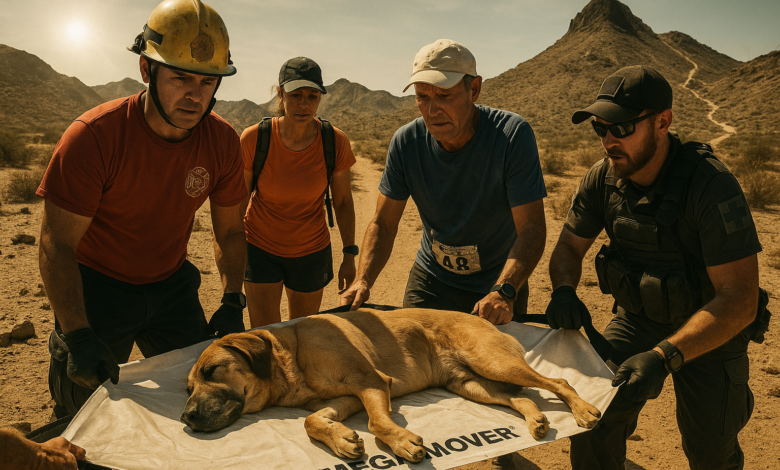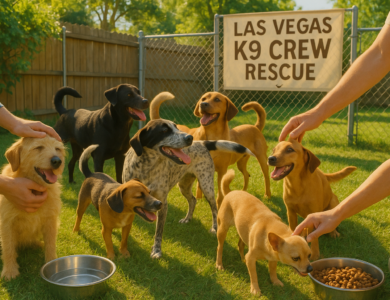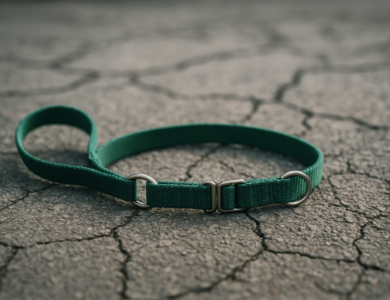Oso’s Desert Rescue Highlights the Hidden Dangers of Hiking with Dogs

What began as a routine outdoor challenge quickly turned into a life-or-death ordeal. During the Lizard Peak Scramble, a 5K and 10K trail run near Lake Havasu — roughly 150 miles south of Las Vegas — a large dog named Oso, weighing over 100 pounds, became severely exhausted and unable to continue the trek, reports 8 News Now.
Responders from the Mohave County Sheriff’s Office Search and Rescue team were called to the scene, where they used a specialized “megamover” transport device to carry the overheated dog to safety. Fellow race participants assisted, creating a powerful display of teamwork and compassion in the face of crisis.
Authorities made it clear that the rescue wasn’t about assigning blame. Instead, it was a crucial reminder that desert heat can overwhelm dogs far faster than humans, regardless of breed, size, or stamina.
Why Dogs Struggle in Desert Heat
The physiology of dogs makes them particularly vulnerable in arid conditions. Unlike humans, who sweat to regulate body temperature, dogs rely mostly on panting — and to a limited degree, the sweat glands in their paw pads — to release heat. In desert environments, this mechanism simply isn’t enough.
Once the air temperature climbs past 85°F, even brief exposure can become dangerous. At just 77°F, pavement can reach 125°F, hot enough to burn paw pads within seconds. By 90°F, surfaces like asphalt and sand can soar above 140°F, radiating heat back onto your pet with devastating effects.
While humans may feel comfortable under a cloudless desert sky, dogs experience a far harsher reality — one that can lead to heat exhaustion or heatstroke in mere minutes if precautions aren’t taken.
Spotting the Early Signs of Trouble
Recognizing early distress in dogs is critical. The first signs of trouble often include heavy panting, thick drool that appears stickier than usual, and bright red gums or tongue. Their heart rate may quicken, and they may appear unusually thirsty or restless.
As overheating progresses, symptoms become far more alarming. A dog may slow down dramatically, stumble, or appear confused. Some vomit or experience diarrhea, while others collapse altogether. These are signs of advanced heatstroke and demand immediate action.
Move your dog into shade right away, offer cool but not icy water, and gently wet their fur with a damp towel. Avoid using ice, as sudden temperature changes can shock the system. Most importantly, seek veterinary attention without delay. Dogs that survive one heatstroke are more likely to suffer another, so prevention becomes paramount.
Staying Safe on the Trail
The best way to protect your dog in the desert is through preparation and timing. In regions like Las Vegas and southern Nevada, hikes should be limited to the early morning before 9 AM or late evening after 6 PM, when temperatures are lowest and ground surfaces have cooled. The months between October and April are generally safest for outdoor adventures.
Hydration is non-negotiable. A dog needs roughly one ounce of water per pound of body weight each day, and significantly more during physical activity. Carry a separate supply for your pet — at least a full liter — and offer water frequently. Every pause for a snack, photograph, or view should double as a hydration break.
Paw protection is equally vital. Before stepping onto a trail, place the back of your hand on the ground for several seconds. If it’s too hot for you, it’s too hot for them. Specialized dog boots, such as the Ruffwear Grip Trex or Canada Pooch Hot Pavement Boots, can make all the difference, providing both heat resistance and traction on rocky terrain.
Above all, be honest about your dog’s fitness level. Age, breed, and body type matter. Flat-faced breeds such as Bulldogs, Pugs, and Boxers struggle to cool themselves, while overweight, senior, or double-coated dogs also tire faster. Build endurance gradually — don’t expect a dog accustomed to short neighborhood walks to handle a strenuous mountain trail.
And perhaps the most important lesson of all: know when to turn back. If your dog starts lagging, lying down, or showing signs of disinterest, that’s the moment to stop. Once half your water supply is gone, it’s time to return. Every extra minute in rising heat could spell trouble.
Safer Dog-Friendly Trails Around Las Vegas
Not every outdoor adventure has to mean risk. Fortunately, southern Nevada offers plenty of dog-friendly trails that balance scenery with safety.
Just 17 miles from the Strip, Red Rock Canyon National Conservation Area boasts more than 30 miles of trails that welcome leashed pets. The Calico Tanks, Pine Creek Canyon, and Oak Creek Canyon routes are local favorites, especially between October and March when temperatures hover in the mid-60s.
An hour north lies Mount Charleston, where mountain trails are up to 20 degrees cooler than the Las Vegas Valley. Fletcher Canyon Trail, a moderate 3.4-mile route, is popular among dog owners looking for shade and fresh mountain air.
For those seeking solitude, Lake Mead National Recreation Area offers striking red rock vistas and quieter paths such as the Bowl of Fire, where bighorn sheep are occasionally spotted. Closer to the city, options like Lone Mountain Trail, Exploration Peak Park, and the River Mountains Loop Trail provide panoramic views and varying difficulty levels — all requiring leashes and proper cleanup.
Being Ready for the Unexpected
Even the best-prepared hikers can find themselves in trouble when nature takes a turn. The desert’s beauty hides its unpredictability — temperatures can swing 30 degrees in a single day, sudden wind gusts can stir up dust that blinds and disorients, and a wrong turn can quickly lead to dehydration or panic. Being ready for the unexpected isn’t just about packing extra water — it’s about planning for everything that could go wrong, and hoping none of it does.
Before setting out, identify emergency veterinary clinics and save their contact numbers on your phone. In the Las Vegas area, VEG Las Vegas on South Rampart Boulevard operates 24/7, while the Animal Emergency Center of Las Vegas and Henderson can be reached at (702) 457-8050. Durango Animal Hospital also offers on-call veterinarians for after-hours emergencies. If you’re venturing outside city limits, research rural vet clinics or mobile animal services along your route before you go offline — many desert areas have limited or no cell service.
A canine first-aid kit should be as essential as your leash. Include gauze rolls, adhesive bandages, antiseptic wipes, and blunt-ended scissors for trimming fur around wounds. Tweezers or hemostats are invaluable for removing cactus spines or embedded thorns. A small bottle of hydrogen peroxide (for wound cleaning or, in extreme cases, to induce vomiting under vet guidance) and electrolyte powder made for pets can help stabilize your dog before reaching medical help.
If your dog takes medication, bring at least two extra doses. Heat, dehydration, or altitude can worsen conditions like heart disease, arthritis, or respiratory issues, and being without medication can quickly escalate an emergency. Store medications and food in insulated containers to protect them from desert temperatures, which can spoil sensitive items in under an hour.
Carrying a portable emergency stretcher or dog sling can be a lifesaver if your pet becomes immobile. Many lightweight versions fold down to fit in a backpack and can help you transport your dog safely over rough terrain until help arrives. If you’re hiking alone, this can be the difference between life and death for a large breed that cannot walk.
It’s also wise to carry multiple navigation tools. GPS apps can fail without signal, so download offline trail maps, carry a physical paper map, and mark waypoints. A simple whistle or small mirror can serve as emergency signaling tools if you become stranded. Always tell someone where you’re going, what trail you’re taking, and when you expect to return.
The desert’s isolation means help is often miles away. Never underestimate how quickly a situation can deteriorate — especially when you’re responsible for another life. Even short hikes can become dangerous if you lose your bearings or run out of water. Treat every desert outing like a backcountry expedition: plan for the best, but prepare for the worst.



